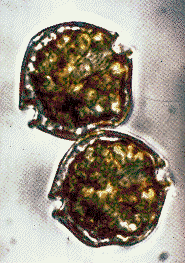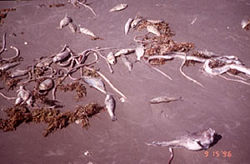Alexandrium tamarense
| Alexandrium tamarense | ||||||||||||||
|---|---|---|---|---|---|---|---|---|---|---|---|---|---|---|
 | ||||||||||||||
| Scientific classification | ||||||||||||||
| ||||||||||||||
| Binomial name | ||||||||||||||
| Alexandrium tamarense |
Picture courtesy of USGS Woods Hole Science Center Synonyms: Gonyaulax tamarensis Lebour 1925 , G. excavata (Braarud) Balech 1971 Protogonyaulax tamarensis (Lebour) F. J. R. Taylor 1979
Description and significance
Alexandrium tamarense is a single-celled, phototrophic dinoflagellate found in coastal marine environments throughout the world and is associated with algal blooms that result in the phenomenon known as red tides (pictured below).
At only 25-46 micrometers in length per cell A. tamarense is microscopic in size, often brown in color and somewhat spherical in shape.
The algal blooms caused by A. tamarense often result in millions of these cells per liter of seawater. Each of these cells produces a neurotoxin that is highly toxic to inhabitants such as fish and shellfish, and can be passed through the food chain to other organisms such as marine mammals, birds, and humans.[1]
Genome structure
There are many different Alexandrium species and DNA sequencing is the best way to distinguish between them.
Like other dinoflagellates, Alexandrium tamarense consists of large amounts of DNA compared to other eukaryotic organisms. It also lacks nucleosomes. It consists of 144 chromosomes which are condensed in the nucleus until DNA replication. A total of 11,103 nucleotides [218 nucleotide core and 10,885 expressed sequence tags (ESTs)] have been sequenced.[2]
It is still not clear which genes play a role in toxin production.
Cell structure and metabolism
Like other dinoflagellate species, A. tamarense is photoautotrophic meaning it manufactures its own food by using energy is obtains from sunlight. It is considered a primary producer and is a source of food for many other organisms. It is a also motile organism, having two flagella which it uses to propel itself through water.[3]
A. tamarense is considered "armored" because it is surrounded by a layer of cellulose that form plates known as thecae.
A. tamarense is very similar morphologically to other species in the same genus, however it can be distinguished by the presence of a ventral pore on the 1' plate, and the shape and size of its cells and thecal plates.
A. tamarense reproduces asexually by binary fission, however it can also reproduce sexually with anisogamous mating types. During sexual reproduction, gametes fuse producing a planozygote which then converts into a resting cyst until environmental conditions are sufficient for germination. Life cycle stages include motile vegetative cells, haploid gametes, diploid zygotes, resting cysts, and temporary cysts.[4]
Ecology
Many dinoflagellates provide a food source for various organisms such as fish and shellfish that feed on primary producers. Some like Alexandrium tamarense are toxic, however, and have devastating effects on the environment and its inhabitants.
While some organisms are unaffected by the toxins produced by A. tamarense, these toxins can accumulate to extremely high levels in the organisms and can be very dangerous to higher organisms that consume them. Consumption of infected organisms can lead to many different illnesses. Paralytic Shellfish toxins (PST) are the primary cause of illness by A. tamarense.
Fish that affected by this illness and also attack the central nervous system, fish are no longer able to breathe in these environments and this often leads to fish kills (pictured right)
Alexandrium tamarense is known for its ability to adapt quickly to different levels of nitrogen, making it more likely to survive in a constantly changing environment.
Pathology
Not all strains of Alexandrium tamarense are toxic. Different strains are often found in the same algal blooms caused by this species.[5]
However, some strains of Alexandrium tamarense produce very potent neurotoxins known as paralytic shellfish toxins (PSTs). These toxins, which include gonyautoxins, neosaxitoxin and saxitoxin, affect fish, marine mammals, birds, and humans.[6]
Many deaths have been reported from the consumption of shellfish infected with these toxins.[7]
Resting cysts can harbour PSP toxins, it was been demonstrated that cysts were more toxic than their motile stage. Humans, other mammals, fish and birds can be affected. Please consult original reference for further details. Harmful species http://www.algaebase.org/search/species/detail/?species_id=40299[8]
Application to Biotechnology
While it is unclear whether toxins produced by A. tamarense provide any health benefits to humans, toxins created by similar dinoflagellates have already shown some benefits. An example of this is Gonyautoxin, a paralyzing phototoxin which aids in the healing of anal fissures.
Current Research
A recent increase in harmful algal blooms produced by A. tamarense and similar species have caused concern for fisheries around the world.
Areas along the coast of Maine have had outbreaks year after year prompting a five year project which is currently underway at Woods Hole Institute's Anderson Laboratory. This project is focused on the abundance, distribution, and motility of A. tamarense in the region. (http://www.whoi.edu/redtide/labweb/projects.html)[9]
At the Hong Kong University of Science and Technology, scientists tried to determine the effects of A. tamarense on energy budgets and growth of two marine bivalves, the Manila clam (Ruditapes philippinarum) and the green-lipped mussel (Perna viridis). They found that scope of growth and absorption efficiency decreased when these bivalves were exposed to PSP.(http://www.sciencedirect.com/science?_ob=ArticleURL&_udi=B6V7H-44PWXYG-2&_user=699469&_rdoc=1&_fmt=&_orig=search&_sort=d&view=c&_acct=C000039278&_version=1&_urlVersion=0&_userid=699469&md5=e22cc9ea0a95b7c463337a6ff596c71e)[10]
At the University of Iowa, scientists were able to sequence the most extensive collection of ESTs for A. tamarense. This will certainly help future research in understanding "the unique and complex cell biology of these organisms and for potentially identifying the genes involved in toxin production." (http://www.pubmedcentral.nih.gov/articlerender.fcgi?artid=1173104)
References
- ↑ [1]
- ↑ Jeremiah D Hackett, Todd E Scheetz, Hwan Su Yoon, Marcelo B Soares, Maria F Bonaldo, Thomas L Casavant, and Debashish Bhattacharya corresponding author, Department of Biological Sciences and Roy J. Carver Center for Comparative Genomics, University of Iowa, Iowa City, IA 52242, USA
- ↑ [2]
- ↑ [3]
- ↑ [4]
- ↑ [5]
- ↑ [6]
- ↑ [7]
- ↑ Don Anderson WHOI, Brad Butman USGS, Peter Franks SIO, Rocky Geyer WHOI, Ted Loder UNH, Rich Signell USGS, Bruce Keafer WHOI, Derek Fong WHOI, "Toxic "Red Tide" Populations in the Western Gulf of Maine: Sources, Transport, and Nutrient Environment
- ↑ Effects of toxic dinoflagellate Alexandrium tamarense on the energy budgets and growth of two marine bivalves, Siu-ChungLi, Wen-Xiong Wang,and Dennis P. H. Hsieh, Department of Biology, The Hong Kong University of Science and Technology (HKUST), Clear Water Bay, Hong Kong, People's Republic of China


